Today, I plan to cook Mee Hailam, a well-known noodle dish in Malaysia. Despite its Chinese name, it is popular among Malays and can be found on the menu of most Malay restaurants. This dish’s cooking technique and ingredients are quite distinct from traditional Chinese cuisine. It is a fascinating dish that I would like to share the recipe with you.
Mee Hailam is a popular dish influenced particularly by Hainanese cooking methods. It is prepared with noodles called mee kuning, a choice of meat and seafood, and plentiful vegetables flavored with sweet soy sauce, oyster sauce, and others.
The origin of Mee Hailam is obscured, but it is believed to be influenced by Hainanese Chinese cooking methods. In the mid-19th century, Hainanese migrants brought their cooking techniques and dishes, creating dishes such as chicken rice, chicken chop, and Mee Hailam, to Malaysia and Singapore. These dishes were adapted to suit local palates, resulting in the unique fusion of Chinese-style cooking methods and flavors from the characteristic local ingredients and culture.
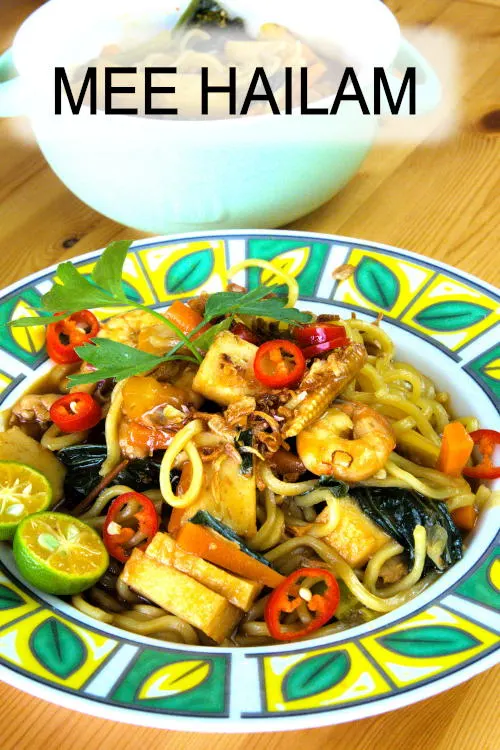
Note: This post may contain affiliate links. Please read my privacy policy for more info. I may receive commissions for purchases made through links in this post. As an Amazon Associate, I earn from qualifying purchases.
How to Prepare Mee Hailam
Although Mee Hailam sounds like a Chinese dish, it is a popular Malay cuisine. This dish is a testament to the unique blend of Chinese and Malay cooking styles, creating a delicious and distinct Malaysian flavor.
1. Prepare the noodles
- Blanch the Mee Kuning in water to remove the excess oil.
- Place the noodles in the water and loosen them slowly, making sure not to break them.
- Transfer the noodles into a colander to remove any excess water once loosened.
Note:
Mee Kuning is a type of cooked noodle that is locally available and commonly used to prepare Mee Hailam. It is sold in vacuum packaging. However, if you can’t find Mee Kuning, you can use other noodles to prepare Mee Hailam.
2. Preparation of the Mee Hailam gravy
Preparation of the gravy can be done separately with the noodles. Usually, a large batch of gravy is made in the restaurants. When served, the cook will mix the right portion of the gravy with the noodles, heat it, and then serve it to the customers. I do the same at home as I do not eat it right after cooking and do not want my noodles to turn soggy.
- First, chop a few cloves of garlic. Then, slice some shallots and cut a carrot into sticks.
- Next, separate the leaves of Choy Sum from the stalk and cut the stalk to about half an inch in length. If I don’t have Choy Sum, I will use Chinese broccoli (Gai Lan) instead.
- Cut one medium-sized tomato into small cubes and a few baby corn at an angle into slices. Also, I will include some squid, but that is optional.
- For the protein, I use chicken breast meat by cutting it into bite-size pieces and marinating it with light soy sauce, salt, and oil for about 15 minutes. You can use chicken thigh meat or substitute it with beef. Besides, I also cut two pieces of fish cakes into thick slices, but you can use fish balls as an alternative.
- Lastly, I removed the shrimp’s head, shell, and legs, deveined it, and left the tail on for a better presentation.
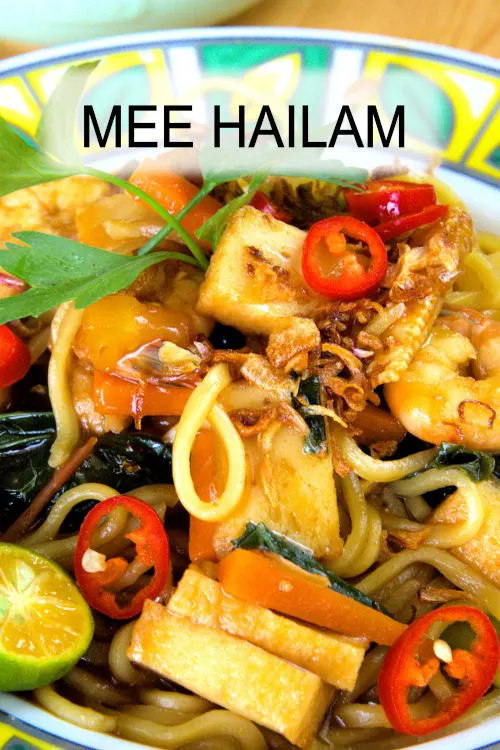
3. Cook the gravy
Although the gravy requires a list of ingredients, cooking is relatively easy.
- Start by heating some oil in a pan to sauté the shallot and garlic until it becomes automatic.
- Then, add a tablespoon of chili paste. You can use pre-made chili paste purchased from the grocery store or make your own by blending a few red chilies with water. Adjust the amount of chili paste based on how spicy you want it.
- Add the marinated chicken pieces and stir-fry until the chicken is cooked.
- Season it with ground white pepper.
- Next, add the Choy Sum stalk and carrots.
- Pour enough water into the pan to cook for a minute or two until the vegetable stalks and carrots turn soft.
- Season with chili, tomato, sweet soy sauce, and oyster sauce.
- Add the fish cakes, baby corn, and shrimp.
- Finally, add the Choy Sum leaves and tomatoes.
- Taste the dish and adjust the seasoning as needed.
- Mix two teaspoons of cornstarch with two tablespoons of cold water to form a slurry in a separate bowl. Gradually add the slurry to the gravy to thicken it. Stop adding the slurry once the gravy reaches the desired thickness. You might not need to use all of it.
To serve
- Once the gravy for the Mee Hailam is ready, mix the blanched yellow noodles with the gravy.
- Transfer the noodles to the serving plate.
- Garnish with lime wedges, fried shallots, and coriander leaves to serve.
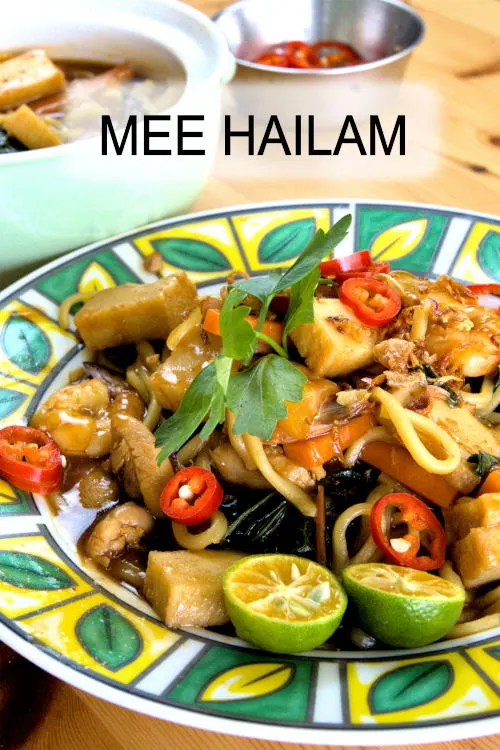
Other related recipes
I hope you enjoyed the traditional Mee Hailam that I prepared. Besides that, I’d like to share some other delicious Malaysian recipes with you.
- Hainanese chicken rice, similar to Mee Hailam, is a localized version of Chinese cuisine. This chicken rice is renowned for its smooth texture and is so popular that many specialty shops exclusively serve it. My food blog has a recipe explaining how to make it at home.
- Hainanese pork chop is a unique dish from the Hainanese chef who worked in Malaysia during the colonial era. They incorporated their cooking techniques into Western pork chops, making it a specialty dish in Malaysia.
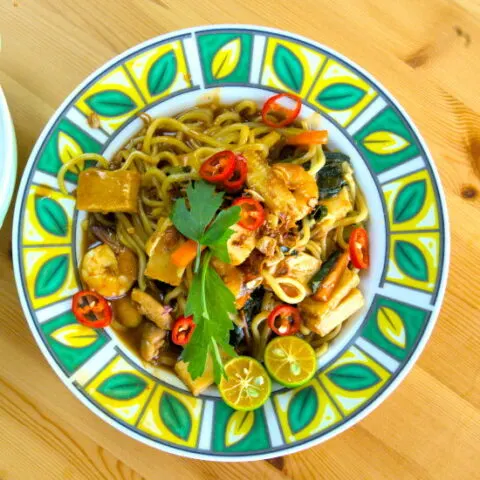
Mee Hailam recipe- Malaysian noodles with Hainanese influence
Delicious Mee Hailam prepared with mee kuning and braised in thick gravy. It is a classic Malay-style noodle dish with a Hainanese influence.
Ingredients
Ingredients A
- 450g yellow noodles (One packet)
- 200g chicken meat (breast or thigh, cut into bite-size)
- 1/4 tsp salt (to marinate meat)
- 1 tsp light soy sauce (to marinate meat)
Ingredients B (Gravy)
- 2 tbsp vegetable oil
- 2 cloves of garlic, chopped
- 3 shallots, sliced
- 1 tbsp chilli paste
- 1 small carrot, cut into batons
- 2 stalks of Choy Sum, cut into sections
- 2 pieces fishcake, cut into thick slices
- 3 cups water
- 3 tbsp tomato sauce
- 2 tbsp chilli sauce
- 1.5 tbsp oyster sauce
- 1tsp salt
- 6 shrimp, deveined, remove shell, leg and head
- 1 tbsp sweet soy sauce
- 4 babycorns, cut into slices
- 2 tsp cornflour (dilute with 2 tbsp of cold water to form a slurry)
- 1 tomato, cut small
- 1/4 tsp ground white pepper
- 1/2 tsp salt
Ingredients C (Garnish + topping)
- Fried shallots
- Coriander leaves
- Lime wedges
Instructions
- Blanch the Mee Kuning in water to remove the excess oil. Drain the noodles into a colander.
- Cut the chicken breast meat into bite-size pieces and marinate it with light soy sauce, salt, and oil for about 15 minutes.
- Hear some oil in a pan to sauté the shallot and garlic until it becomes automatic.
- Then, add a tablespoon of chili paste.
- Add the marinated chicken pieces and stir-fry until the chicken is cooked.
- Season it with ground white pepper.
- Next, add the Choy Sum stalk and carrots.
- Pour enough water into the pan to cook for a minute or two until the vegetable stalks and carrots turn soft.
- Season with chili sauce, tomato sauce, sweet soy sauce, and oyster sauce.
- Add the fish cakes, baby corn, and shrimp.
- Finally, add the Choy Sum leaves and tomatoes.
- Thicken the gravy with cornstarch slurry.
- Mix the gravy with the noodles.
- Garnish with lime wedges, fried shallots, and coriander leaves to serve.
Recommended Products
As an Amazon Associate and member of other affiliate programs, I earn from qualifying purchases.
-
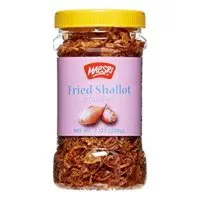 Maesri Fried Shallot, 7 Ounce
Maesri Fried Shallot, 7 Ounce -
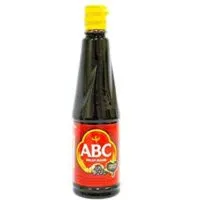 Kecap Manis Plastic Bottle (Sweet Soy Sauce Plastic Bottle) - (Pack of 3)
Kecap Manis Plastic Bottle (Sweet Soy Sauce Plastic Bottle) - (Pack of 3) -
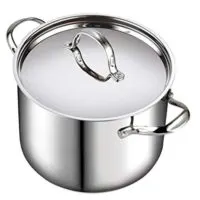 Cooks Standard 02520 Quart Classic Stainless Steel Stockpot with Lid, 12-QT, Silver
Cooks Standard 02520 Quart Classic Stainless Steel Stockpot with Lid, 12-QT, Silver -
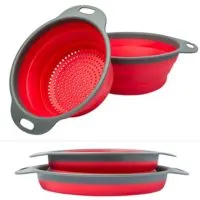 Colander Set - 2 Collapsible Colanders (Strainers) Set By Comfify - Includes 2 Folding Strainers Sizes 8" - 2 Quart and 9.5" - 3 Quart Red and Grey
Colander Set - 2 Collapsible Colanders (Strainers) Set By Comfify - Includes 2 Folding Strainers Sizes 8" - 2 Quart and 9.5" - 3 Quart Red and Grey
Nutrition Information:
Yield: 3 Serving Size: 1Amount Per Serving: Calories: 660Total Fat: 18gSaturated Fat: 3gTrans Fat: 0gUnsaturated Fat: 13gCholesterol: 81mgSodium: 2263mgCarbohydrates: 90gFiber: 9gSugar: 18gProtein: 38g
This data was provided and calculated by Nutritionix on 10/24/2023

Irene Wong
Thursday 26th of October 2023
How long do I need to blanch the noodles in boiling water?
KP Kwan
Sunday 12th of November 2023
Just long enough to make it hot, about 15-20 seconds. The noodles I used are a type of cooked noodle.
KP Kwan
Wednesday 25th of October 2023
Hi, this is KP Kwan. I am happy to see you in this comment area, as you have read through my recipe. I am glad to reply to any questions and comments as soon as possible.